We may earn revenue from the products available on this page and participate in affiliate programs. Learn More ›
Nothing is quite as aggravating as discovering that the delivery guy’s van leaked oil on your driveway or that the dried leaves you didn’t sweep up last fall created stubborn brown stains that won’t rinse away. But your home’s curb appeal doesn’t have to suffer a setback.
With the right supplies and a little elbow grease, you’ll soon have your driveway looking good again. Whatever the stain or discoloration on your driveway, here are some of the best driveway cleaning techniques to solve it.
Everything You Need to Know About Driveway Cleaning
A well-used driveway—especially a DIYer’s driveway—is prone to all sorts of stains, from paint and varnish overspray to dribbles of motor oil, and even an occasional permanent marker when the kids play hopscotch. Some stains and debris can be swept away or washed off with a garden hose, while others require applying stain-removal products.
The type of driveway (concrete or asphalt), as well as the type of stain, play a role in determining the best way to clean a driveway.
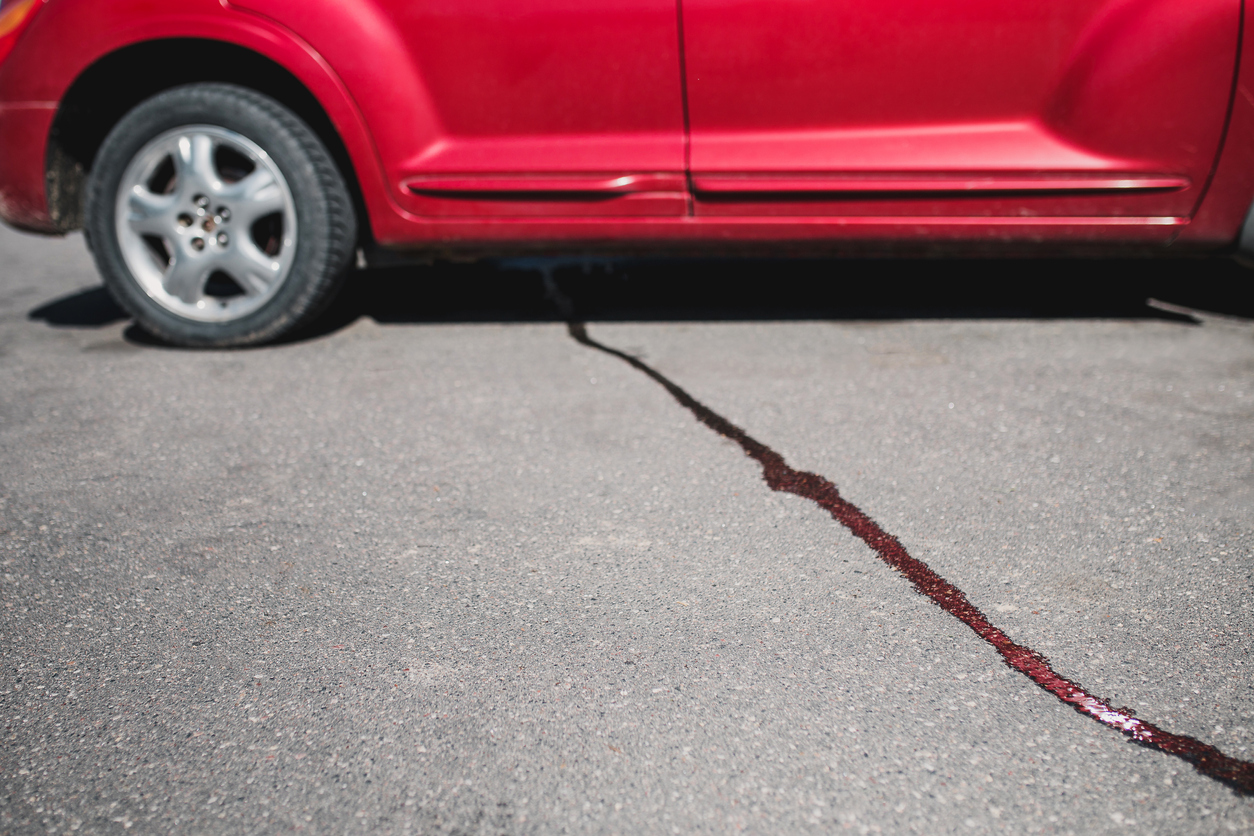
How to Clean Auto-Related Oil and Solvent Spills From a Driveway
Motor oil, brake fluid, and gasoline spills are more visible on concrete than asphalt (asphalt’s black coloring hides the stain some), but it’s still imperative to promptly clean these stains off both types of driveways to prevent unsightly stains. What’s more, auto-related oils and solvents can interact with asphalt’s petroleum base, causing it to deteriorate and soften.
On either type of driveway, first soak up as much of the fresh spill as possible with an absorbent product, such as clay-based kitty litter. Give it a few hours to absorb the excess spill, then scoop up the litter and sweep the area. For some types of spills, this might be all that’s necessary. However, if residual stains are left, use one of the following driveway-cleaning techniques for your specific hardscape material to remove the rest.
- Asphalt follow-up: After absorbing the excess spill, spray a biodegradable oven cleaning product on the remaining spill (make sure it specifies “biodegradable” so that you do not splash or rinse away caustic chemicals into your lawn or garden beds). Let it sit for up to 30 minutes before rinsing away with a garden hose. Just as an oven cleaner dissolves tough grease in your oven, it will break down the remaining oil or solvent, allowing you to rinse it away safely.
- Concrete follow-up: Unlike asphalt, concrete’s slightly porous surface allows spills to seep into its tiny holes. For a clean concrete driveway, the best way to remove the remaining product from concrete is to first dissolve it and then draw it out.
- Mix a moisture-absorbing product into liquid TSP to create a thick paste for cleaning concrete stains. (Corn starch works for small spills. For larger spills, try diatomaceous earth, available for purchase online and at garden or swimming pool supply stores.) Spread the paste over the affected area, be it a fresh spill or an old stain. Work it into the concrete surface with a stiff-bristle nylon brush.
- Spread an additional thin layer of the paste on top and let it dry completely. The TSP will break down the oil or solvent components, and the absorbing product will bind them. Depending on outdoor temperature and humidity, the paste could take anywhere from 30 minutes to a couple of hours.
- Use a putty knife to scrape away the dried paste and then rinse with a hose or power washer. Old stains might require more than one application to remove.
How to Remove Tire Marks From a Driveway
Brake a bit too quickly, and your car can leave unsightly black tire marks on the driveway that won’t rinse off. Tire marks are virtually invisible on asphalt driveways, but they’re a sore spot on concrete. Cleaning them requires a bit of elbow grease, but not too much. These simple steps make it a snap.
- First, spray a natural driveway cleaner and degreasing product, such as Organic Orange (available from Amazon) on the marks and let it sit for a few minutes to help loosen and dissolve the spots.
- Before the concrete cleaner evaporates, scrub the marks with a stiff nylon bristle brush.
- Spray away the residue using the jet setting on a garden hose nozzle, or use a power washer.
- If necessary, repeat the steps.
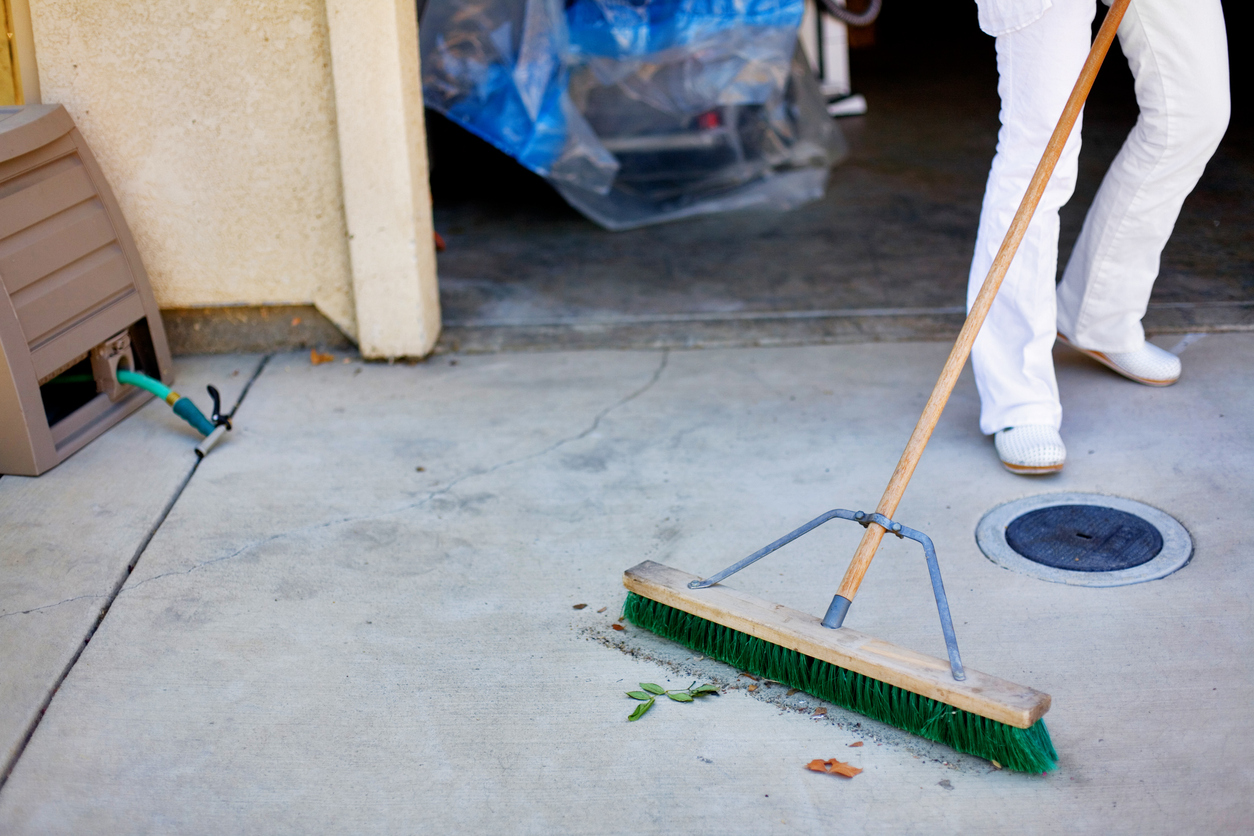
How to Clean Dirt, Mud, and Rock-Related Debris From a Driveway
After a winter of snow and slushy roads, it’s nearly impossible to keep automobile tires from tracking dirt and mud onto your driveway, where the dirt hardens like a rock as it dries. If you have a pressure washer, this is an excellent time to bring it out; if you don’t, you can clean away the dirt and mud with a stiff-bristle push broom and a garden hose.
This driveway cleaning technique works equally well for dirty asphalt and concrete driveways. First, sweep away loose dirt and bits, then dampen caked-on mud and let the water soak in a few minutes before scrubbing the loosened mud with the push broom to break it up. Depending on how much you have to remove, this could take a while. The trick is to use plenty of water.
How to Clean Decomposing Organic Matter From a Driveway
If you neglect to rake up the mess of organic matter that has spilled onto your concrete driveway, piles of mulch, fallen leaves, and pine needles can leave harmless yet unattractive brown stains behind. (These only appear on concrete since darker asphalt can mask the color.)
As organic items decompose, they release tannin, a colorful byproduct of the natural decaying process. Though the color eventually will fade from concrete, you can help hurry the process along with a little bit of driveway cleaning. Learning how to clean concrete driveway stains is a straightforward process:
- Sweep the concrete surface, then spray the stained area with a garden hose to rinse away dirt. In a large plastic bucket, mix ½ cup of liquid dish detergent into 3 gallons of hot water. (Or, for the best results on tannin stains, use a powdered laundry detergent that’s advertised as being good at removing food stains.)
- Slowly pour the solution onto the tannin stains and work the liquid into the concrete using a stiff-bristle nylon brush.
- Rinse with the garden hose; while the concrete is still wet, sprinkle powdered laundry detergent over the stains and scrub again. Leave the detergent on for a few minutes, then rinse away.
- Repeat if necessary.
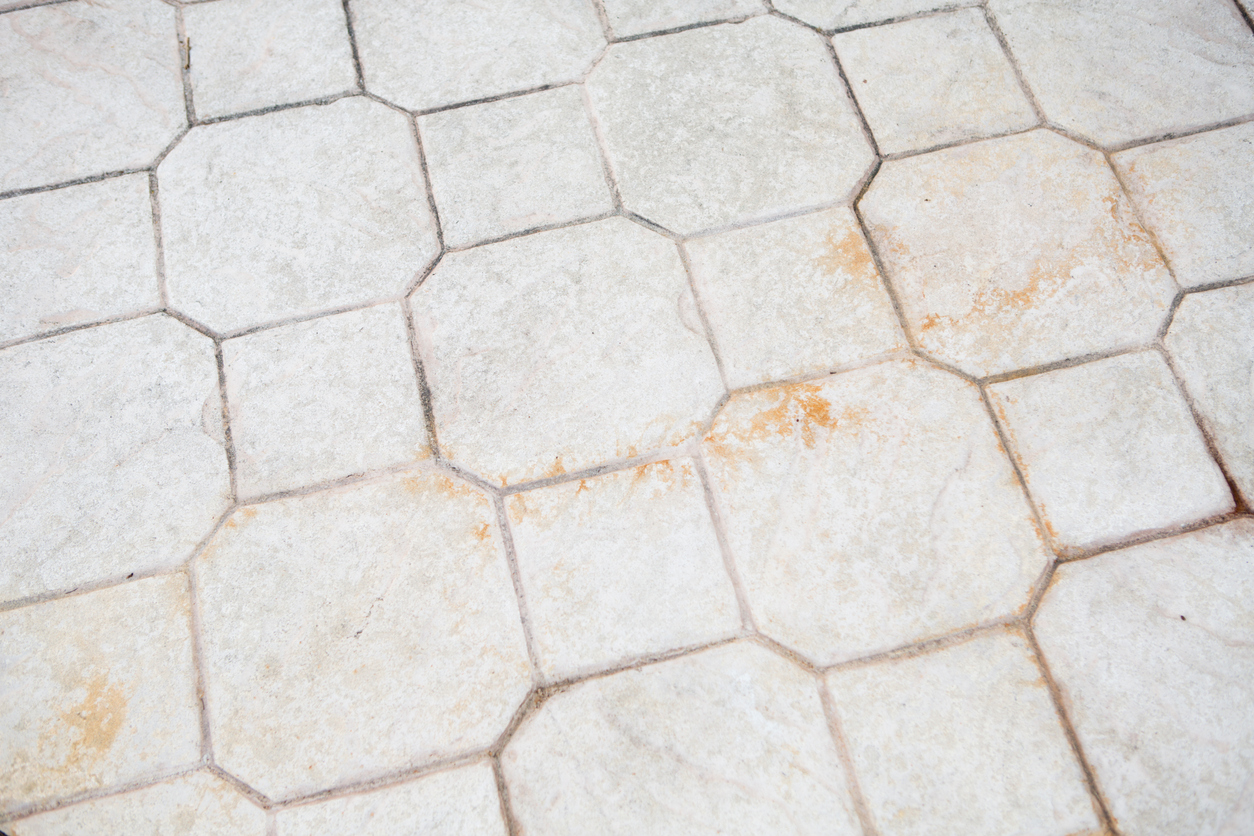
How to Remove Fertilizer Stains From a Driveway
If strange yellowish-orange stains appear along the edges of a concrete driveway within a day or two of applying a lawn fertilizer, they’re probably a type of rust stain caused by the iron in the fertilizer. The good news is that over time, they’ll probably fade away by themselves, but if you’re not into waiting, there’s a simple fix.
You can apply a commercial rust remover product that’s safe for use on concrete, such as Iron OUT (available from Amazon). While spraying white vinegar on rust stains is a well-known method of removing them, using vinegar frequently in the same spot can weaken the internal cement bond within the concrete and cause the driveway’s surface to soften and spale.
How to Clean Mold and Mildew From a Driveway
If the driveway is in a humid area, especially in the shade, both mold and mildew can get a foothold. Mildew appears as a powdery white stain that spreads, while mold can be dark green, brown, black, or multicolored. Mold and mildew will grow on both concrete and asphalt driveways, but mold might not be visible on an asphalt driveway. The presence of a musty smell indicates that an asphalt driveway might have a mold infestation.
Cleaning mold or mildew from a concrete or asphalt driveway is a snap when using an outdoor mold killer such as 30 Seconds Outdoor Cleaner (available from Amazon). The product comes in a sprayer that attaches to a garden hose. Just spray on, wait a few minutes, and then hose off with clean water.
How to Clean Paint Spills and Splatters From a Driveway
Paint splatters left behind from a furniture project you brought outdoors are a nuisance on both concrete and asphalt. If dealing with a latex-based paint spill, you often can remove the stain by wetting the splatter with water, sprinkling on household scouring powder, and scrubbing it with a stiff-bristle nylon brush. Then rinse with a garden hose.
Oil- and acrylic-based paint splatters are tougher to remove. If you have an asphalt driveway, the best solution might be to coat the driveway (or just the paint-splattered area) with an asphalt sealer, which will renew its black surface and cover splatters. The solvent that removes oil-based paint actually can damage asphalt, and is suitable for concrete driveways only.
Removing paint from concrete is similar to removing it from an old piece of furniture you’re refinishing—strip it off! Pour or brush a paint-stripping solution on the splatters, and work it into the concrete with a stiff, natural-bristle brush. Leave it on for the time specified by the manufacturer and then rinse it away.
Since you’ll be rinsing the paint stripper away, it’s a good idea to use a product that’s safe for the environment. Low-VOC strippers such as Citristrip (available at The Home Depot) are good choices for the job.
How to Clean Rust Stains From a Driveway
While not an issue on black asphalt driveways, rust is an eyesore on concrete—and happens as quickly as overnight. Just leaving a paint can out on the driveway during a rainstorm can result in a dark rusty circle by morning. Fortunately, muriatic acid will remove rust stains without much trouble, but this harsh acid (available at most hardware stores) requires extra safety precautions when using it. Wear long rubber gloves and protective eyewear, and follow the motto you learned in high school science class: “Do how you otter (ought to), add acid to water.”
By slowly pouring ¼ cup acid into a bucket already filled with 2 cups of cold water, you’ll minimize the risk of splashes. If any solution does splash onto your skin, rinse it off promptly to avoid irritation. Then, carefully pour the mix onto the rust stain and gently scrub the surface of the concrete with a stiff-bristle nylon brush. Allow the driveway cleaning solution to remain on for a few minutes before rinsing away with a garden hose. Heavy rust stains may require two or more treatments.
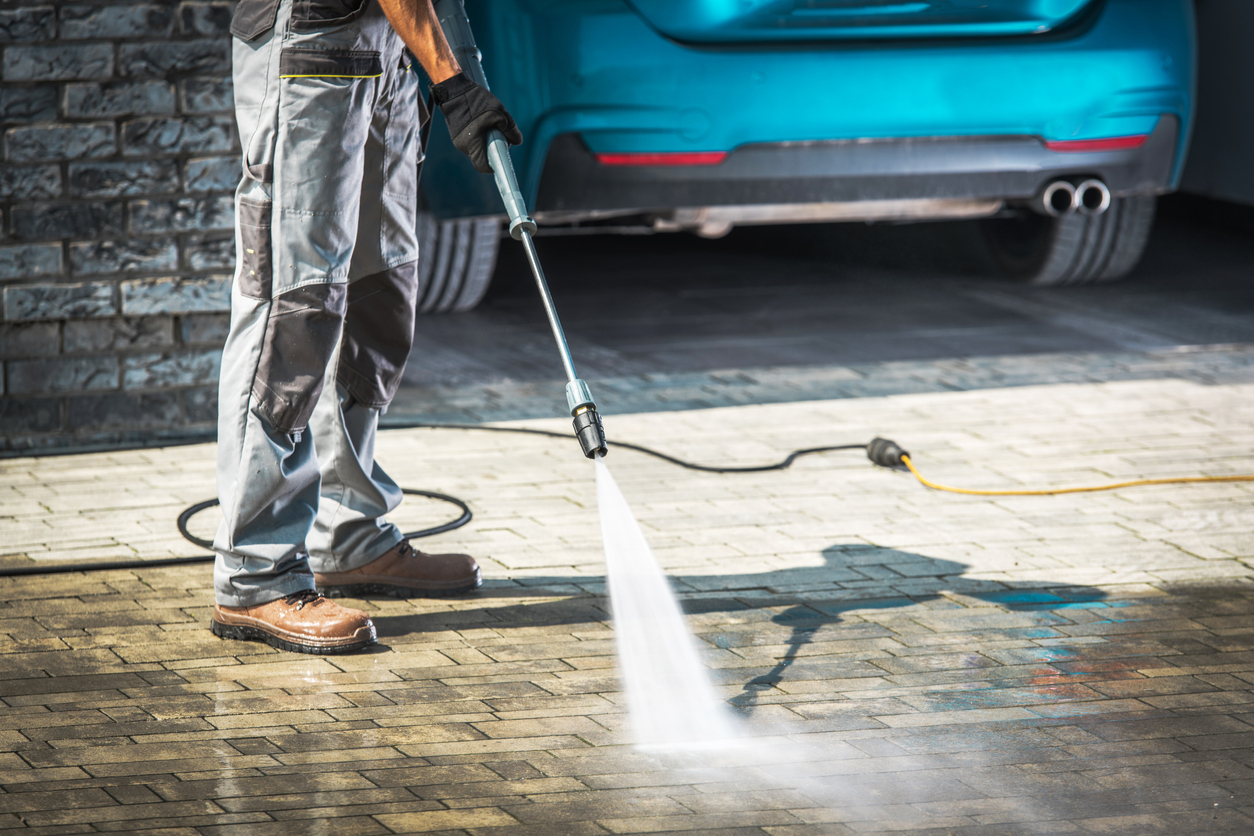
FAQs About Driveway Cleaning
As the first thing visitors see as they approach your home, the driveway should be clean and clear of stains to make the best first impression. Whether it’s made from concrete or asphalt, cleaning stains from the driveway will freshen the entire front yard’s appeal. Those who are facing the prospect of removing stubborn stains might have some questions.
Q. How much psi do I need to clean my driveway?
For the best results, use a power washer with at least 3,000 psi.
Q. How long does a pressure-washed driveway last?
Pressure washing is an excellent way to remove a number of stains, but it only lasts until the driveway gets dirty again. Maintaining a cleaner concrete driveway is an ongoing process.
Q. Does vinegar damage concrete driveways?
Vinegar is an old standby for removing light rust stains from concrete, but if used frequently, it can weaken the cement within the concrete, so opt for a rust-removing product that’s designed to be safe for concrete driveways.
Q. Will straight bleach harm concrete?
Bleach will not harm concrete—even if applied at full strength—but for most stain-removing applications, using full-strength bleach isn’t necessary. A bleach solution that’s diluted at the rate of 1 cup of bleach per 1 gallon of water is sufficient.
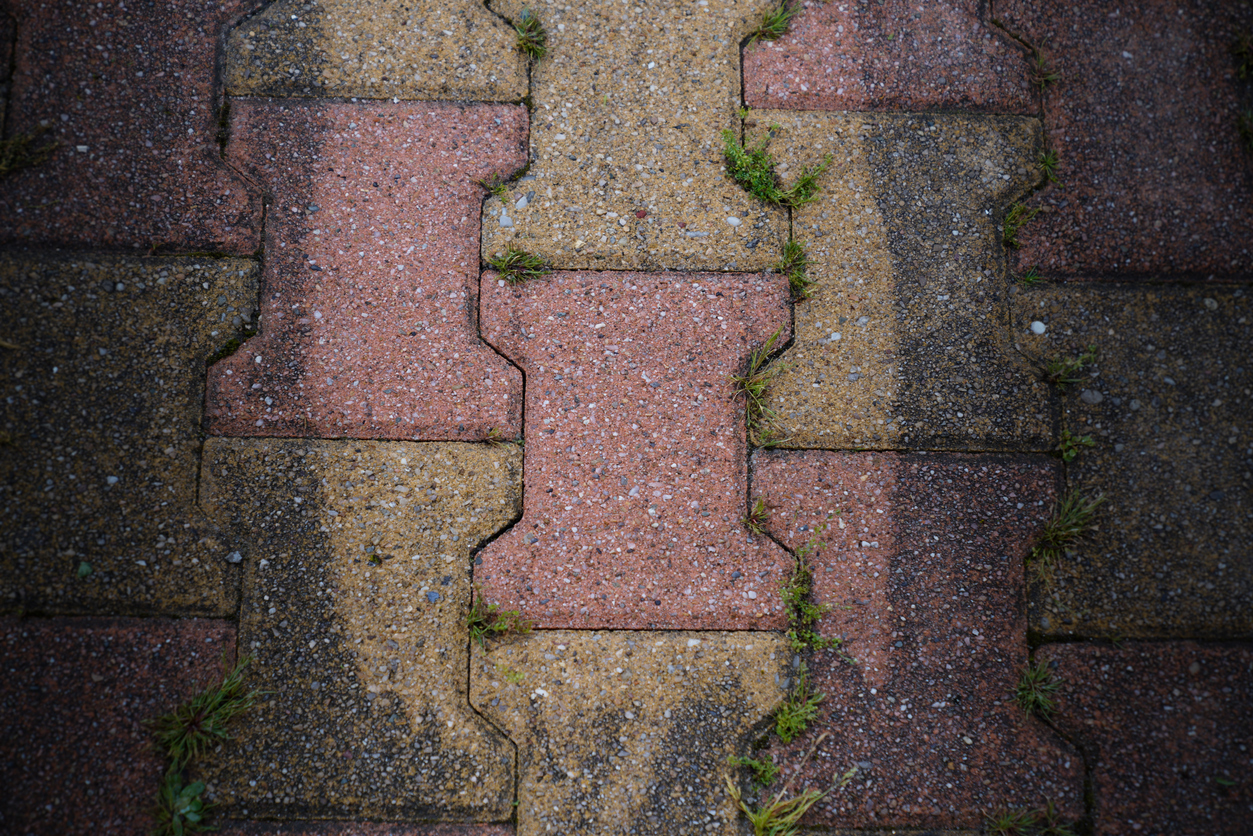
Final Thoughts
The best way to keep the driveway clean is to remove stains promptly. When two or more types of stains are on the driveway, such as mud and mechanic’s grease, it can make the whole home look neglected and shoddy. The longer some stains such as paint splatters sit, the more challenging they can be to remove.
Keep a bag of inexpensive, clay-based kitty litter in the garage for quick spill absorption, and follow the above techniques for keeping the drive looking its best.


